HONDA ELEMENT 2011 1.G User Guide
Manufacturer: HONDA, Model Year: 2011, Model line: ELEMENT, Model: HONDA ELEMENT 2011 1.GPages: 286, PDF Size: 14.07 MB
Page 11 of 286

This section gives you important
information about how to protect
yourself and your passengers. It shows
you how to use seat belts. It explains
how your airbags work. And it tells you
how to properly restrain infants and
children in your vehicle.
Important Safety Precautions
.............
6
Your Vehicle's Safety Features
..........
7
Seat Belts
.....................................
8
Airbags
........................................
9
Protecting Adults and Teens
...........
11
1. Close and Lock the Doors
........
11
2. Adjust the Front Seats
.............
11
3. Adjust the Seat-Backs
..............
12
4. Adjust the Head Restraints
......
13
5. Fasten and Position the Seat Belts
..................................
14
6. Maintain a Proper Sitting Position
..............................
15
Advice for Pregnant Women
........
16
Additional Safety Precautions
......
16
Additional Information About Your Seat Belts
...............................
18
Seat Belt System Components
.....
18 Lap/Shoulder Belt
......................
19
Automatic Seat Belt Tensioners
.............................
20
Seat Belt Maintenance
................
20
Additional Information About Your Airbags
..................................
22
Airbag System Components
........
22
How Your Front Airbags Work
....
24
How Your Side Airbags Work
......
28
How Your Side Curtain Airbags Work
.....................................
29
How the SRS Indicator Works
.....
30
How the Side Airbag Off Indicator Works
.....................
31
How the Passenger Airbag Off Indicator Works
.....................
32
Airbag Service
............................
33
Additional Safety Precautions
......
33
Protecting Children -General
Guidelines
..............................
35
All Children Must Be
Restrained
..............................
35
All Children Should Sit in a Back Seat
.......................................
36
The Passenger's Front Airbag Can Pose Serious Risks
...........
36 If You Must Drive with Several
Children
................................
38
If a Child Requires Close Attention
................................
38
Additional Safety Precautions
......
39
Protecting Infants and Small Children
.................................
40
Protecting Infants
.......................
40
Protecting Small Children
...........
41
Selecting a Child Seat
.....................
42
Installing a Child Seat
.....................
43
Installing a Child Seat with
LATCH
..................................
44
Installing a Child Seat with a Lap/Shoulder Belt
..................
46
Installing a Child Seat with a Tether
...................................
48
Protecting Larger Children
.............
49
Checking Seat Belt Fit
................
49
Using a Booster Seat
...................
50
When Can a Larger Child Sit in
Front
.....................................
50
Additional Safety Precautions
......
51
Carbon Monoxide Hazard
...............
52
Safety Labels
..................................
53
Driver and Passenger Safety
5
Driver and Passenger Safety
10/08/06 08:34:41 11 ELEMENT MMC North America Owner's Man 50 31SCV680 enu
Page 12 of 286

You'll find many safety
recommendations throughout this
section, and throughout this manual.
The recommendations on this page
are the ones we consider to be the
most important.Always Wear Your Seat BeltA seat belt is your best protection in all
types of collisions. Airbags are
designed to supplement seat belts, not
replace them. So even though your
vehicle is equipped with airbags, make
sure you and your passengers always
wear your seat belts, and wear them
properly (see page 14).Restrain All ChildrenChildren age 12 and under should ride
properly restrained in a back seat, not
the front seat. Infants and small
children should be restrained in a
child seat. Larger children should use
a booster seat and a lap/shoulder belt
until they can use the belt properly
without a booster seat (see pages
35-51).
Be Aware of Airbag HazardsWhile airbags can save lives, they can
cause serious or fatal injuries to
occupants who sit too close to them, or
are not properly restrained. Infants,
young children, and short adults are at
the greatest risk. Be sure to follow all
instructions and warnings in this
manual.Don't Drink and DriveAlcohol and driving don't mix. Even one
drink can reduce your ability to respond
to changing conditions, and your
reaction time gets worse with every
additional drink. So don't drink and
drive, and don't let your friends drink
and drive, either.Pay Appropriate Attention to the
Task of Driving SafelyEngaging in mobile phone conversation
or other activities that keep you from
paying close attention to the road, other
vehicles and pedestrians could lead to a
crash. Remember, situations can
change quickly, and only you can
decide when it is safe to divert attention
away from driving.
Control Your SpeedExcessive speed is a major factor in
crash injuries and deaths. Generally, the
higher the speed, the greater the risk,
but serious injuries can also occur at
lower speeds. Never drive faster than is
safe for current conditions, regardless
of the maximum speed posted.Keep Your Vehicle in Safe ConditionHaving a tire blowout or a mechanical
failure can be extremely hazardous. To
reduce the possibility of such problems,
check your tire pressures and condition
frequently, and perform all regularly
scheduled maintenance (see page 185).
Important Safety Precautions610/08/06 08:34:41 11 ELEMENT MMC North America Owner's Man 50 31SCV680 enu
Page 13 of 286
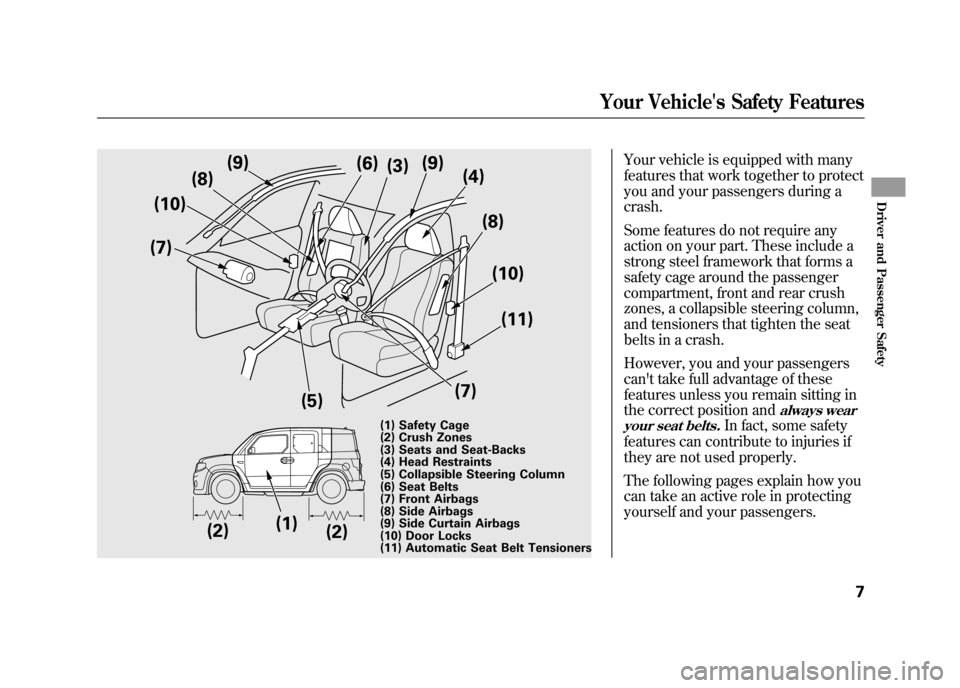
Your vehicle is equipped with many
features that work together to protect
you and your passengers during a
crash.
Some features do not require any
action on your part. These include a
strong steel framework that forms a
safety cage around the passenger
compartment, front and rear crush
zones, a collapsible steering column,
and tensioners that tighten the seat
belts in a crash.
However, you and your passengers
can't take full advantage of these
features unless you remain sitting in
the correct position and
always wear
your seat belts.
In fact, some safety
features can contribute to injuries if
they are not used properly.
The following pages explain how you
can take an active role in protecting
yourself and your passengers.
(5) (7)(11)
(8)
(3)
(4)
(9)
(1) (2)
(8)
(10)
(2)
(1) Safety Cage
(2) Crush Zones
(3) Seats and Seat-Backs
(4) Head Restraints
(5) Collapsible Steering Column
(6) Seat Belts
(7) Front Airbags
(8) Side Airbags
(9) Side Curtain Airbags
(10) Door Locks
(11) Automatic Seat Belt Tensioners
(6)
(7) (10)
(9)
Your Vehicle's Safety Features
7
Driver and Passenger Safety
10/08/06 08:34:41 11 ELEMENT MMC North America Owner's Man 50 31SCV680 enu
Page 14 of 286

Seat Belts
Your vehicle is equipped with seat
belts in all seating positions.
Your seat belt system also includes
an indicator on the instrument panel
and a beeper to remind you and your
passengers to fasten your seat belts.Why Wear Seat BeltsSeat belts are the single most
effective safety device for adults and
larger children. (Infants and smaller
children must be properly restrained
in child seats.)
Not wearing a seat belt properly
increases the chance of serious
injury or death in a crash, even
though your vehicle has airbags.
In addition, most states require you
to wear seat belts.
Not wearing a seat belt properly
increases the chance of serious
injury or death in a crash, even
though your vehicle has
airbags.
Be sure you and your
passengers always wear seat
belts and wear them properly.
When properly worn, seat belts:●Keep you connected to the vehicle
so you can take advantage of the
vehicle's built-in safety features.●Help protect you in almost every
type of crash, including: – frontal impacts
– side impacts
– rear impacts
– rollovers
●Help keep you from being thrown
against the inside of the vehicle
and against other occupants.●Keep you from being thrown out of
the vehicle.●Help keep you in a good position
should the airbags ever deploy. A
good position reduces the risk of
injury from an inflating airbag and
allows you to get the best
advantage from the airbag.
Of course, seat belts cannot
completely protect you in every
crash. But in most cases, seat belts
can reduce your risk of serious
injury.What You Should Do:Always wear your seat belt, and
make sure you wear it properly.
Your Vehicle's Safety Features810/08/06 08:34:41 11 ELEMENT MMC North America Owner's Man 50 31SCV680 enu
Page 15 of 286
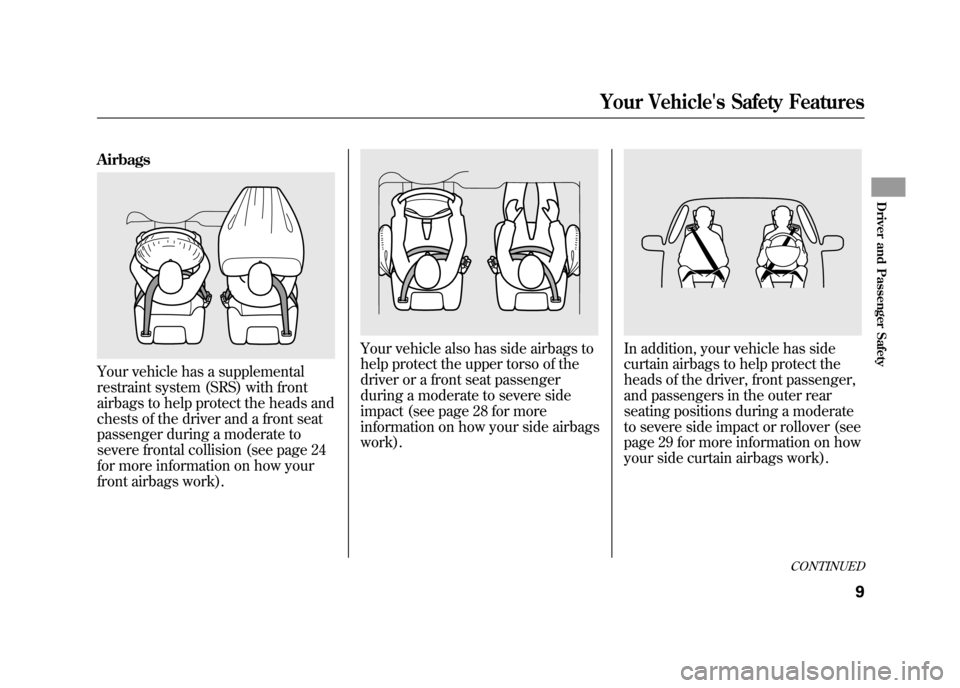
AirbagsYour vehicle has a supplemental
restraint system (SRS) with front
airbags to help protect the heads and
chests of the driver and a front seat
passenger during a moderate to
severe frontal collision (see page 24
for more information on how your
front airbags work).
Your vehicle also has side airbags to
help protect the upper torso of the
driver or a front seat passenger
during a moderate to severe side
impact (see page 28 for more
information on how your side airbags
work).
In addition, your vehicle has side
curtain airbags to help protect the
heads of the driver, front passenger,
and passengers in the outer rear
seating positions during a moderate
to severe side impact or rollover (see
page 29 for more information on how
your side curtain airbags work).
CONTINUED
Your Vehicle's Safety Features
9
Driver and Passenger Safety
10/08/06 08:34:41 11 ELEMENT MMC North America Owner's Man 50 31SCV680 enu
Page 16 of 286

The most important things you need
to know about your airbags are:●Airbags do not replace seat belts.They are designed to supplement
the seat belts.●Airbags offer no protection in rearimpacts, or minor frontal or sidecollisions.●Airbags can pose serious hazards.To do their job, airbags must
inflate with tremendous force. So
while airbags help save lives, they
can cause minor injuries or more
serious or even fatal injuries if
occupants are not properly
restrained or sitting properly.
What you should do:
Always wear
your seat belt properly, and sit
upright and as far back from the
steering wheel as possible while
allowing full control of the vehicle. A
front passenger should move their
seat as far back from the dashboard
as possible. The rest of this section gives more
detailed information about how you
can maximize your safety.
Remember however, that no safety
system can prevent all injures or
deaths that can occur in a severe
crash, even when seat belts are
properly worn and the airbags
deploy.
Your Vehicle's Safety Features1010/08/06 08:34:41 11 ELEMENT MMC North America Owner's Man 50 31SCV680 enu
Page 17 of 286
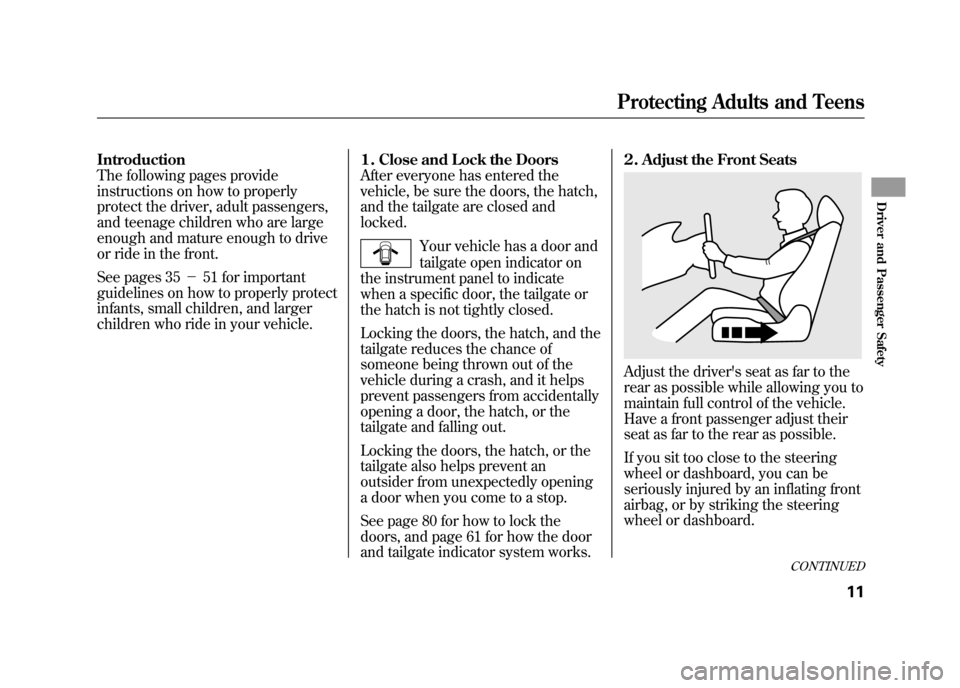
Introduction
The following pages provide
instructions on how to properly
protect the driver, adult passengers,
and teenage children who are large
enough and mature enough to drive
or ride in the front.
See pages 35-51 for important
guidelines on how to properly protect
infants, small children, and larger
children who ride in your vehicle. 1. Close and Lock the Doors
After everyone has entered the
vehicle, be sure the doors, the hatch,
and the tailgate are closed and
locked.
Your vehicle has a door and
tailgate open indicator on
the instrument panel to indicate
when a specific door, the tailgate or
the hatch is not tightly closed.
Locking the doors, the hatch, and the
tailgate reduces the chance of
someone being thrown out of the
vehicle during a crash, and it helps
prevent passengers from accidentally
opening a door, the hatch, or the
tailgate and falling out.
Locking the doors, the hatch, or the
tailgate also helps prevent an
outsider from unexpectedly opening
a door when you come to a stop.
See page 80 for how to lock the
doors, and page 61 for how the door
and tailgate indicator system works. 2. Adjust the Front Seats
Adjust the driver's seat as far to the
rear as possible while allowing you to
maintain full control of the vehicle.
Have a front passenger adjust their
seat as far to the rear as possible.
If you sit too close to the steering
wheel or dashboard, you can be
seriously injured by an inflating front
airbag, or by striking the steering
wheel or dashboard.
CONTINUED
Protecting Adults and Teens
11
Driver and Passenger Safety
10/08/06 08:34:41 11 ELEMENT MMC North America Owner's Man 50 31SCV680 enu
Page 18 of 286
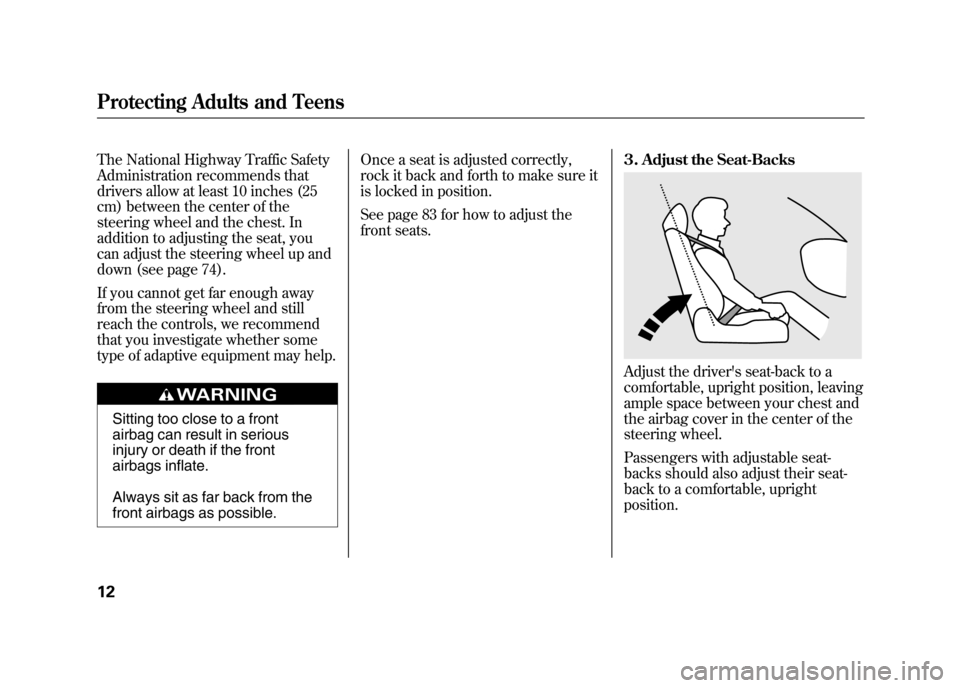
The National Highway Traffic Safety
Administration recommends that
drivers allow at least 10 inches (25
cm) between the center of the
steering wheel and the chest. In
addition to adjusting the seat, you
can adjust the steering wheel up and
down (see page 74).
If you cannot get far enough away
from the steering wheel and still
reach the controls, we recommend
that you investigate whether some
type of adaptive equipment may help.
Sitting too close to a front
airbag can result in serious
injury or death if the front
airbags inflate.
Always sit as far back from the
front airbags as possible.Once a seat is adjusted correctly,
rock it back and forth to make sure it
is locked in position.
See page 83 for how to adjust the
front seats.
3. Adjust the Seat-Backs
Adjust the driver's seat-back to a
comfortable, upright position, leaving
ample space between your chest and
the airbag cover in the center of the
steering wheel.
Passengers with adjustable seat-
backs should also adjust their seat-
back to a comfortable, upright
position.
Protecting Adults and Teens1210/08/06 08:34:41 11 ELEMENT MMC North America Owner's Man 50 31SCV680 enu
Page 19 of 286
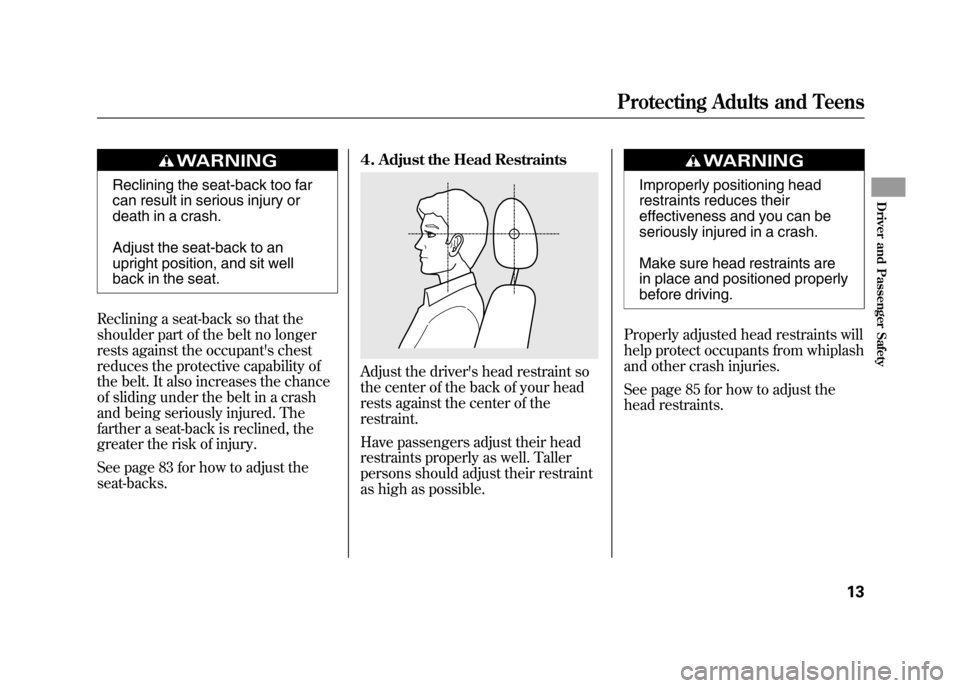
Reclining the seat-back too far
can result in serious injury or
death in a crash.
Adjust the seat-back to an
upright position, and sit well
back in the seat.
Reclining a seat-back so that the
shoulder part of the belt no longer
rests against the occupant's chest
reduces the protective capability of
the belt. It also increases the chance
of sliding under the belt in a crash
and being seriously injured. The
farther a seat-back is reclined, the
greater the risk of injury.
See page 83 for how to adjust the
seat-backs. 4. Adjust the Head Restraints
Adjust the driver's head restraint so
the center of the back of your head
rests against the center of the
restraint.
Have passengers adjust their head
restraints properly as well. Taller
persons should adjust their restraint
as high as possible.
Improperly positioning head
restraints reduces their
effectiveness and you can be
seriously injured in a crash.
Make sure head restraints are
in place and positioned properly
before driving.
Properly adjusted head restraints will
help protect occupants from whiplash
and other crash injuries.
See page 85 for how to adjust the
head restraints.
Protecting Adults and Teens
13
Driver and Passenger Safety
10/08/06 08:34:41 11 ELEMENT MMC North America Owner's Man 50 31SCV680 enu
Page 20 of 286
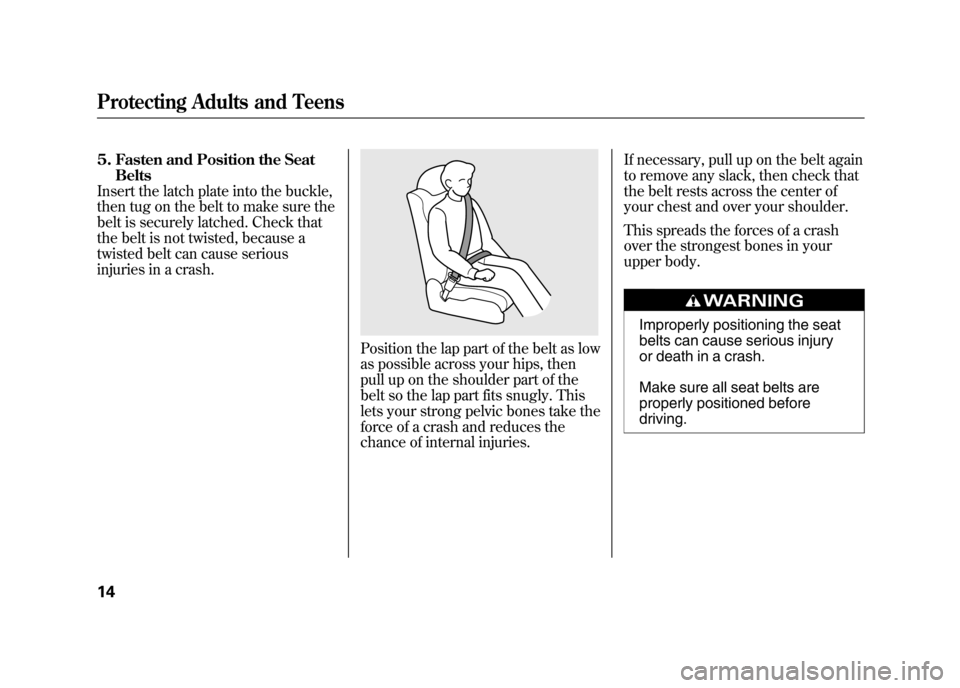
5. Fasten and Position the SeatBelts
Insert the latch plate into the buckle,
then tug on the belt to make sure the
belt is securely latched. Check that
the belt is not twisted, because a
twisted belt can cause serious
injuries in a crash.
Position the lap part of the belt as low
as possible across your hips, then
pull up on the shoulder part of the
belt so the lap part fits snugly. This
lets your strong pelvic bones take the
force of a crash and reduces the
chance of internal injuries. If necessary, pull up on the belt again
to remove any slack, then check that
the belt rests across the center of
your chest and over your shoulder.
This spreads the forces of a crash
over the strongest bones in your
upper body.
Improperly positioning the seat
belts can cause serious injury
or death in a crash.
Make sure all seat belts are
properly positioned before
driving.
Protecting Adults and Teens1410/08/06 08:34:41 11 ELEMENT MMC North America Owner's Man 50 31SCV680 enu